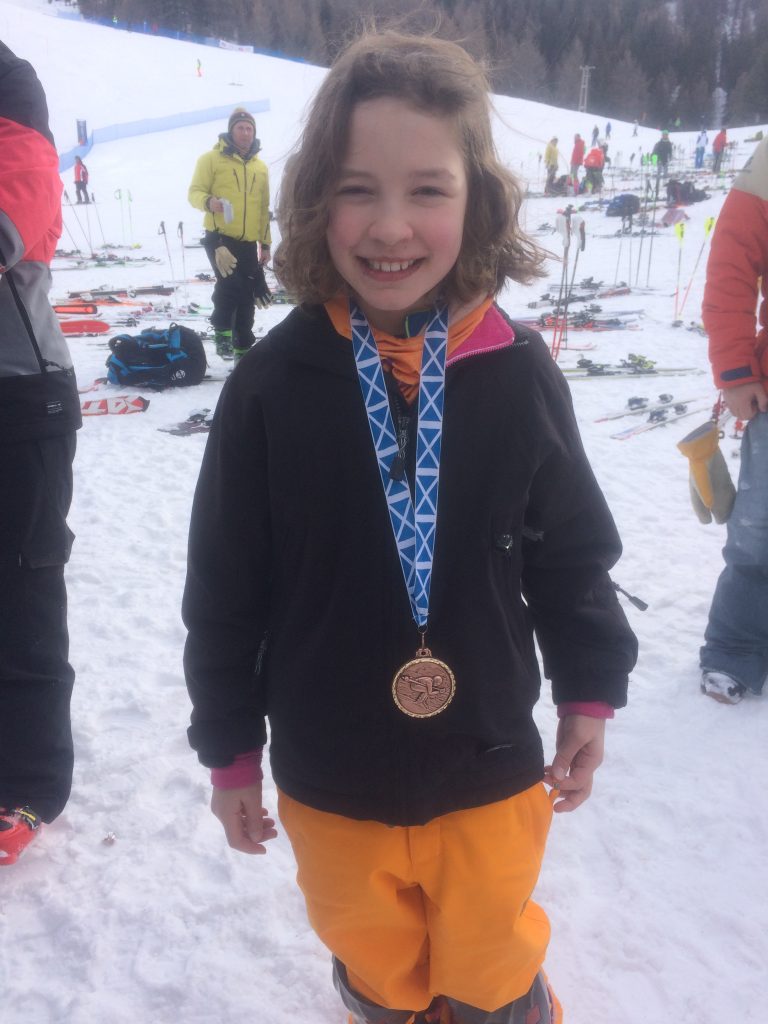Once you have decided that ski racing is for you, thoughts often turn to what kit do you need? Ski racing is sport that appears to demand lots of kit, but it is possible to enjoy racing without spending a fortune . This guide has been put together to help you work out your buying priorities and give you some ideas and tips.
We recommend that when buying kit that you seek expert advice if you are unsure about what to purchase. The opinions expressed in this article are no substitute of that advice. SASA does not endorse nor profits from any of the organisations mentioned in this article.
Helmet
Buying
This is a good place to start. A helmet is required for all ski racing. To start off, you do not need a specific racing helmet for race practice and entry level racing such as the SASA Winter League, but it must not have any attachments (e.g. GoPro fixings).
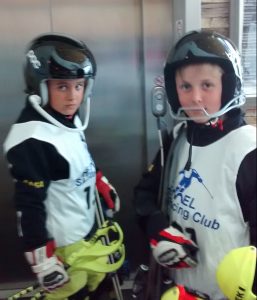
There are Federation Interationale du Ski (FIS) rules specifically for ski helmets, which can be found on the GBSKI website www.gbski.co.uk/. The rules are slightly different for slalom and giant slalom (GS), buy a GS helmet which you can add chin guard onto for slalom races is good idea. If you are slalom racing on full height gates, you will need a chin guard. The race bulletin, which is issued when entry opens for a race, will provide you with the rules for helmets for that particular race.
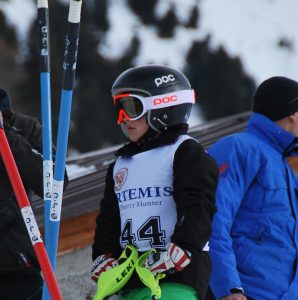
It is very important that you get a helmet properly fitted. You should not assume that the same size across different manufacturers (and even different models across the same manufacturers) will be the same fit. You will often see Ski Bartlett www.skibartlett.com (who give 10% to SASA members), Ski Bitz www.skibitz.co.uk and Wellsnowsports www.wellsnowsports.com at local race events, all of whom will be able to fit a race helmet and advise on the options to suit the skiing that you want to do.
If you decide that you want to buy a helmet secondhand, be sure that you know that it hasn’t been subjected to a major impact and is less than five years old (it is not recommended that helmets over five years old are used).
Care
Once you have purchased your helmet, treat it with respect! Keep it in a helmet bag to prevent small scratches and scrapes and DO NOT DROP IT!
A quick spray of Frabreze or specific helmet sanitizer after use, particularly in the summer is a good idea as winter gear can get very damp and sweaty on a hot summer’s day!
Boots
Buying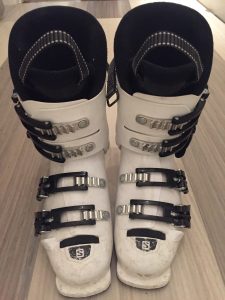
Often, the second purchase for aspiring racers, this is a major investment, so, again, this is a it is advisable to get them fitted by a specialist. Locally, Snowtrax www.snowtraxstore.co.uk in Christchurch, Snow & Rock in Port Solent www.snowandrock.com and Rinskis near Chichester www.rinskis.co.uk all do boot fitting. Snowtogs in Southampton www.snowtogs.com don’t carry childen’s boots in stock but will order them in (and fit them) for you. Further afield , Ski Bartletts www. Skibartlett.com in Hillingdon have a wide selection. Don’t be tempted to buy children’s boots with lots of growing room as the boots need to be reasonably snug in order for them to transmit movement to the skis. If your children are skiing regularly, they may even wear the boots out before they grow out of them!
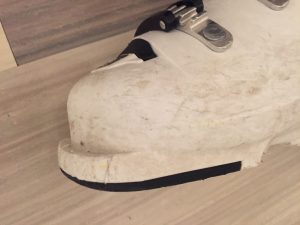
Boots sizes are measured in mondo points, which is the sole length of the foot in centimetres. Boot shells are normally produced to accommodate two different mondo sizes (achieved by using different sized liners), so you will often see these two sizes marked on the boots (e.g. 24/24.5) There is also a boot shell/sole length, which will also be marked on the boot. This, longer, length is required when bindings are set on the skis.
If you are buying second-hand, check that the toes and heels of the boots that fit into the bindings are not damaged to the point that they interfere with the binding. There are many guides for fitting boots on the internet, so take the time to familiarise yourself with what to look for, as ill-fitting boots are at best, uncomfortable and will not help your skiing.
Care
Always keep your ski boots buckled up when not in use so as to prevent them from being pulled out shape.
Pull the liners out periodically and after use in wet weather to ensure that the liners can dry out.
Using boots in the summer means that they can get very smelly! Using a deodorising spray will help to minimise the pong!
Body Protection
Buying
Many racers wear back protectors and most slalom racers have pole and shin guards.
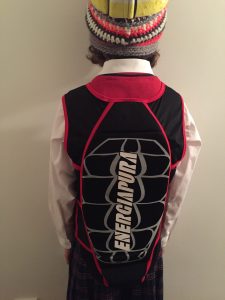
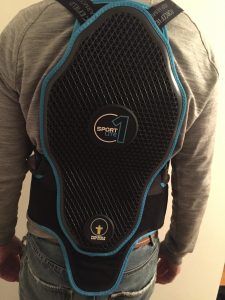
Back protectors come in two main forms – gilet style or straps holding the protector in place. They both do the same job, so its personal preference as to which to use. Back protectors must fit snugly into the small of the back and the top must not protrude above the shoulder line. If it does, there is a danger that the back protector can ride up and damage the wearer’s neck
Shin guards, do just that. Made from hard plastic, they are usually attached around the shin with velcro straps, but some manufacturers do make a pull on version.
Pole guards come in a variety of styles – half and full hand; open and closed. For anyone racing on full gates, the full, closed guards are the most popular. Pole guards can be fitted on most standard poles. Skiers new to racing should not rush to get pole guards or shin guards too soon. Its not uncommon for racers to try to hit the poles once they get shin and pole guards, which has a very negative effect on their technique! Neither pole nor shin guards are really necessary when skiing on stubbies. Talk to your coach about when to invest in them.
Care
All of this kit is quite robust – just don’t lose it!
Skis & Poles
As with all of the information, this is only a very high level guide to get you started. Dong some research will give you the best chance of getting a suitable ski at the right price. The internet is a good source, but don’t forget all the other racers who have been through the same research process. Its also a great way to break the ice at training sessions as there are not many (any?) people at race training who are not happy to talk about skis!
Clothing
On the dry slope, long sleeved tops and loose trousers are ideal. SASA has a range of kit that is perfect for the dry slope SASA Kit Shop. Gloves are also required on the dry slope (but do not need to be ski gloves, which is a relief in the summer!)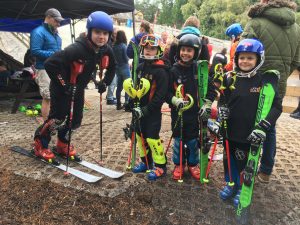
For training at Landgraaf and Alpine racing, normal snow gear (salopettes, ski jacket and lots of layers) is used by many racers. Trespass offer 10% discount on skiwear for SASA members. For details, see Trespass Offer. Alpine racers over 12 often wear catsuits (catsuits are banned from U12 and below races) and U12 trainees can wear them when training with SASA.
Transporting Kit
A strong kit bag, which can accommodate boots, helmet, shin guards and ski maintenance equipment is a good investment. The ski race suppliers sell them (approximately £60 upwards). There aren’t many styles on the market, so make sure that yours is clearly labelled and distinguishable from the other 30 identical bags at the slope each session!
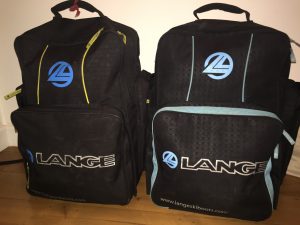 A ski bag (which will also take the poles) is also useful. For children’s skis, it is worth getting hold of a shorter bag. Glisshop www.glisshop.co.uk have some in stock.
A ski bag (which will also take the poles) is also useful. For children’s skis, it is worth getting hold of a shorter bag. Glisshop www.glisshop.co.uk have some in stock.
General Care
At a busy race, there can be a couple of hundred skiers, so that’s a lot of kit to get mixed up. There isn’t much variety available for any ski kit, so it is vital that you have everything clearly named – its not enough for you to be able to identify you kit through distinguishing marks. It is surprisingly common to pick the wrong skis or bag, so make sure that its clear to everyone that its your kit. You have been warned!!!!
